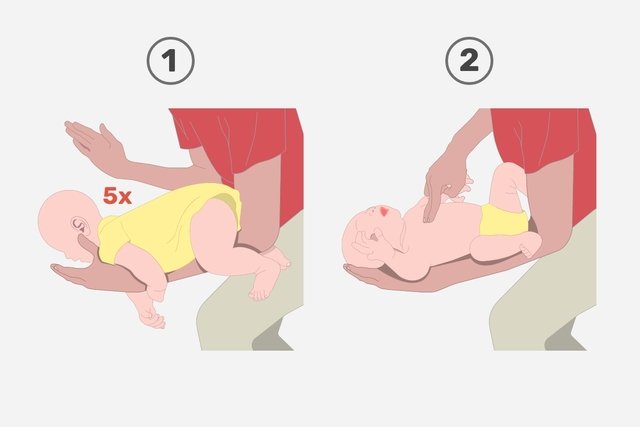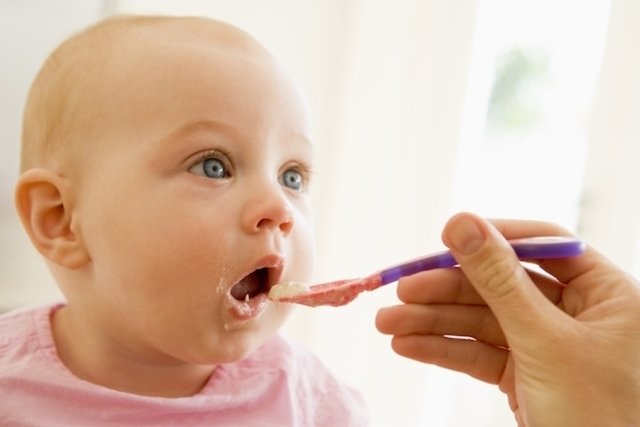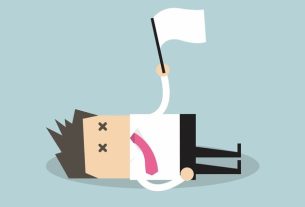When the baby chokes, it is important to remain calm, check if the baby is breathing, crying or coughing, and place the baby on his stomach on his forearm resting on his leg and pat the baby’s back with the heel of his hand.
The baby can choke when eating, drinking a bottle, breastfeeding, or even on his own saliva or small objects, causing symptoms such as coughing, wheezing, difficulty breathing, and, in the most serious cases, bluish lips and paleness.
This occurs when food does not follow its natural destination, which is to go down the esophagus and reach the stomach or due to obstruction by small objects, preventing or blocking the passage of air to the lungs, totally or partially.

What to do when your baby chokes
When your baby chokes, you should:
1. Ask for medical help
- Quickly call SAMU on number 192 or call the fire department on 193, or ask someone to call;
- Check to see if the baby can breathe aloneif you cry or cough.
Even if the baby is breathing hard, this is a good sign because the airway is not completely closed. In this case, it is normal for him to cough a little.
Let him cough as long as necessary and never try to remove the object from his throat with your hands because it could go deeper into the throat.
2. Start the maneuver to unclog
The unblocking maneuver helps to remove the object that is causing the choking. To perform this maneuver you must:
- Lay the child on the arm resting on the leg, with the head a little lower than the torso and observe if there is any object in its mouth that can be easily removed;
- Tilt the baby, with the belly over the armso that the torso is lower than the legs, and give 5 slaps with the heel of the hand on the back;
- If this is still not enough, you should turn the child to facestill on the arm, and perform 5 compressions with the middle and ring fingers on the chest, 1 cm below the region between the nipples;
- Repeat the maneuver until the child cries or coughs without difficulty.
Even if the baby improves, if there is still a suspicion of obstruction of the airways by an object or food, it is important to seek an emergency room for an evaluation.
This maneuver can be done on babies up to 1 year of age. After this age, the Heimlich maneuver can be performed. Learn how to do the Heimlich maneuver.
What to do if the baby is unconscious
If the baby becomes unconscious, it is recommended to begin cardiopulmonary resuscitation, which combines cardiac massage alternated with mouth-to-mouth breathing, while waiting for help.
To perform cardiac massage, you must place the baby lying on the floor or a hard surface, and tilt the baby’s head back slightly to facilitate breathing.
Then, do mouth-to-mouth breathing, covering the baby’s mouth and nose with your mouth, and exhaling air into the baby’s mouth. Then, place your index and middle fingers between the baby’s nipples and perform 2 compressions per second until rescuers arrive. See how to perform cardiopulmonary resuscitation on the baby correctly.
How to know if your baby is choking
The clearest signs that the baby has choked are:
- Coughing, sneezing, retching and crying during eating, for example;
- Breathing may be rapid and the baby may be panting;
- Not being able to breathe, which can cause bluish lips and paleness or redness in the face;
- Absence of respiratory movements;
- Making a lot of effort to breathe;
- Make unusual sounds when breathing;
- Trying to speak but not making a sound.
The situation is more serious if the baby is unable to cough or cry. In this case, the symptoms present are bluish or purplish skin, exaggerated respiratory effort and eventual loss of consciousness.
Some babies may appear to have choked, but when parents are sure that they did not put anything in their mouth, they should take the child to the hospital as quickly as possible because there is a suspicion that they are allergic to some food they have eaten, which caused swelling of the airways and is preventing the passage of air.
What to do after choking your baby
In all cases of choking in the baby, even after carrying out the choking maneuvers and the baby is breathing, it is important to take the baby to the hospital or wait for rescuers to arrive and take him to the hospital.
This is because it is necessary to evaluate and monitor the pediatrician, and observe the baby’s vital data and neurological examination.
Main causes of choking in babies
The most common causes that cause a baby to choke are:
- Drink water, juice or bottle while lying down or lying down;
- Breast;
- Put the baby down after eating or breastfeeding without burping or regurgitating yet;
- Eat grains of rice, beans, slippery pieces of fruit like mango or banana;
- Putting small toys or loose parts such as batteries, batteries or magnets that may be in the toys into your mouth;
- Swallow coins, buttons, candy, gum, popcorn, corn, peanuts.
However, a baby who chokes frequently may have difficulty swallowing, which may indicate diseases such as cerebral palsy or congenital myopathy.
Therefore, especially if other signs, such as developmental delay and feeding difficulties, occur, it is important to consult a neuropediatrician or pediatrician so that they can identify what is happening.
Bibliography
- DUCKETT, S. A.; BARTMAN, M.; ROTEN, R. A. IN: STATPEARLS (INTERNET). TREASURE ISLAND (FL): STATPEARLS PUBLISHING. Choking. 2022. Available at: <https://www.ncbi.nlm.nih.gov/books/NBK499941/>. Accessed on March 4, 2024
- BURNS, Dennis A. R. et al. Textbook of Pediatrics of the Brazilian Society of Pediatrics . 4th ed. Barueri, SP: Editora Manole, 2017. 137-147.

Sign up for our newsletter and stay up to date with exclusive news
that can transform your routine!
Warning: Undefined array key "title" in /home/storelat/public_html/wp-content/plugins/link-whisper-premium/templates/frontend/related-posts.php on line 12
Warning: Undefined array key "title_tag" in /home/storelat/public_html/wp-content/plugins/link-whisper-premium/templates/frontend/related-posts.php on line 13




